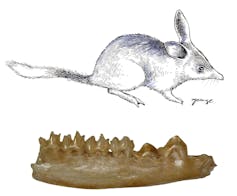Ancient bilby and bandicoot fossils shed light on the mystery of marsupial evolution
- Written by Kenny Travouillon, Curator of Mammals, Western Australian Museum
Bilbies and bandicoots are less famous than koalas and kangaroos, but several species of these small Australian marsupials are highly threatened. Most of us are unlikely to encounter the nocturnal mammals in the wild, though some species of bandicoots are familiar visitors to gardens in urban areas.
Bandicoots and bilbies are also elusive in the fossil record. Fewer than 25 fossil species have been named to date.
Our research published in Alcheringa: An Australasian Journal of Palaeontology, describes the discovery of new fossil species. These include the oldest known bilby and bandicoot fossils, which will allow us to understand better the evolution of these enigmatic marsupials.
Pieces of a very incomplete puzzle
The first fossil bilby ever recovered was discovered by an American palaeontologist, Ruben Stirton, in South Australia in 1955. This fossil was 3.9 million years old, and consisted of a single lower jaw with a few teeth from a species dubbed Ischnodon australis. No other specimens of that species have been recovered since.
Despite many decades of fossil collecting around Australia, no other fossil bilbies were found until 2014. I was researching fossils from the Riversleigh Word Heritage Area in Queensland when I was lucky enough to spot a few teeth which turned out to belong to a primitive bilby.
The new fossil was about ten million years older than Ischnodon australis, and I named the new species Liyamayi dayi. Until now, that was the end of what we know about fossil bilbies.
We have done much better with bandicoot fossils. The first fossil bandicoot, Perameles allinghamensis, was discovered by Michael Archer in 1976 in northern Queensland.
Since then more than 20 species of fossil bandicoots have been named, the bulk of which came from the Riversleigh World Heritage Area. The oldest bandicoot known to date, Bulungu muirheadae, was found in South Australia, and it is about 24.9 million years old.
The discovery of the oldest fossils known
 Reconstruction and fossil of the oldest bilby Bulbadon warburtonae.
Art by George Aldridge / photo by Kenny Travouillon., Author provided
Reconstruction and fossil of the oldest bilby Bulbadon warburtonae.
Art by George Aldridge / photo by Kenny Travouillon., Author provided
For many years, I was lucky enough to work with Michael Archer and colleagues on the fossils from Riversleigh World Heritage Area. The diversity of marsupials discovered there has massively increased our knowledge of their evolution.
I was later able to work with Judd Case at the Eastern Washington University in Spokane. Case has visited Australia on several occasions to collect fossils in South Australia. Fossil sites around Lake Eyre and surrounding lakes have produced some of the oldest fossil marsupials related to our modern species.
Case had also worked with Michael Archer, hunting fossils in the Lake Eyre reigion. During my visit to the US, Case invited me to study all the bilby and bandicoot fossils he had collected.
In this material, I identified four new species. Two of these are the oldest known fossil bandicoot (Bulungu minkinaensis) and the oldest known bilby (Bulbadon warburtonae).
Putting a clock on the evolution of endangered species
 Fossils of three newly discovered bandicoot species.
Kenny Travouillon, Author provided
Fossils of three newly discovered bandicoot species.
Kenny Travouillon, Author provided
Once a new species is discovered, the next step is to work out how it is related to all other known species. This is done with a phylogenetic analysis, which produces a sort of family tree placing the most similar species close together.
My colleague Robin Beck and I found that our oldest bandicoots were part of an ancient group of bandicoots that went extinct around 10 million years ago. In contrast, modern bandicoots have evolved more recently.
Our oldest bilby, however, confirmed previous genetic work showing that bilbies evolved around 30 million years ago. They have slowly adapted as Australia has become more arid, especially since the climate change of the middle Miocene around 15 million years ago.
Authors: Kenny Travouillon, Curator of Mammals, Western Australian Museum





